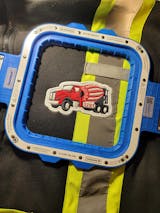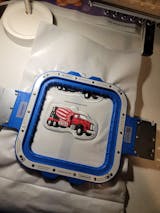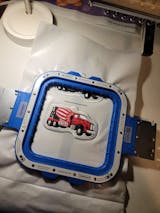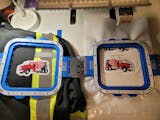1. Introduction: The Critical Role of Needles in Machine Embroidery
Needles may be small, but in the world of machine embroidery using the best embroidery machines, they wield outsized influence. The right needle can mean the difference between crisp, flawless stitches and a frustrating tangle of thread breaks, puckered fabric, or skipped stitches. Every stitch your machine forms depends on the needle’s ability to smoothly guide thread through fabric, maintain tension, and avoid damaging delicate fibers. In this guide, we’ll unravel the essentials: exploring needle anatomy, the vast landscape of needle types, sizing systems, and how to select the perfect match for your project. Whether you’re troubleshooting thread breaks or seeking tips for specialty fabrics, you’ll find actionable insights to elevate your embroidery results from good to truly professional.
Table of Contents
- 1. Introduction: The Critical Role of Needles in Machine Embroidery
- 2. Needle Anatomy and Types: Matching Functions to Fabrics
- 3. Selecting Needle Sizes and Systems for Your Machine
- 4. Needle Maintenance Protocols and Troubleshooting
- 5. Advanced Techniques for Specialty Materials
- 6. Premium Needles: Cost vs. Value Analysis
- 7. Optimizing Needles for High-Density Designs
- 8. Conclusion: Building a Needle Strategy for Flawless Embroidery
- 9. FAQ: Top Embroidery Needle Questions Resolved
2. Needle Anatomy and Types: Matching Functions to Fabrics
Choosing the right embroidery machine needle isn’t just about size or brand—it’s about understanding how every component of the needle interacts with your fabric and thread. Let’s dive into the science behind needle anatomy and explore how different needle types are purpose-built for specific embroidery challenges.
2.1 The Science Behind Needle Components: Shank to Point
Embroidery machine needles are marvels of tiny engineering, each part playing a crucial role in stitch formation and thread protection:
- Shank: The upper part that fits into your machine’s needle bar. Home machines use flat shank needles (flat on one side), while commercial machines use round shanks. Proper insertion—flat side away from you, groove in front—is vital for perfect stitches.
- Blade (Shaft): This is the long, slender section from shank to point. The diameter of the blade determines the needle’s size (e.g., 75 = 0.75mm).
- Groove: Running down the front, the groove cradles the thread as it moves toward the eye. Embroidery needles often have elongated grooves to reduce friction, especially with thicker threads.
- Scarf: The indentation at the back above the eye. A longer scarf makes it easier for the bobbin hook to catch the thread, helping prevent skipped stitches.
- Eye: The hole the thread passes through. Embroidery needles have larger, elongated eyes to accommodate specialty threads and reduce breakage.
- Point and Tip: The business end! Sharps pierce woven fabrics cleanly, while ballpoints push aside knit fibers to avoid snags.
Up close, as seen in magnified video comparisons, you’ll notice subtle differences between brands and types—like a deeper groove or a larger scarf on embroidery needles versus universal ones. These details matter: a longer eye means less friction and fewer thread breaks, while a specialized scarf can be the difference between smooth stitching and constant troubleshooting.
2.2 Sharp vs. Ballpoint vs. Titanium: Application Guidelines
With anatomy mastered, let’s match needle types to their best uses. Here’s a quick-reference table to help you choose:
| Needle Type | Best For | Key Features | Recommended Sizes |
|---|---|---|---|
| Sharp (Standard) | Woven fabrics (cotton, linen, denim) | Pierces fibers cleanly; elongated eye for embroidery thread | 75/11, 80/12, 90/14 |
| Ballpoint | Knits, stretch, spandex, jersey | Rounded tip pushes fibers aside, prevents snags | 75/11, 80/12 |
| Metallic | Metallic/specialty threads | Rectangular, elongated eye; extra-long groove; Teflon coat | 90/14, 100/16 |
| Titanium-Coated (PD) | High-speed, dense, abrasive fabrics | Titanium nitride coating for durability and less friction | 75/11, 80/12, 90/14 |
| Microtex | Fine/microfiber, precision work | Very sharp, narrow blade; acute point for clarity | 70/10, 80/12 |
| Leather/Wedge Point | Soft leather, suede, vinyl | Extra-sharp or wedge tip for tough materials | 70/10, 75/11, 90/14 |
Pro Tips:
- For most embroidery on medium-weight fabric, a 75/11 embroidery needle is your go-to (as echoed by Kimberbell and seasoned embroiderers alike).
- Use a ballpoint for knits—its rounded tip prevents runs and skipped stitches.
- Metallic threads? Opt for a metallic needle with a larger, rectangular eye and Teflon coating to sidestep shredding and heat buildup.
- For heavy fabrics like denim or dense designs, bump up to a 90/14 sharp or titanium-coated needle for added strength.
Remember, even within the same size and type, brands like Schmetz, Organ, and Klasse may have subtle differences in groove depth or eye shape—so don’t hesitate to experiment and find your favorite.
3. Selecting Needle Sizes and Systems for Your Machine
The world of needle sizes and machine compatibility can feel like deciphering a secret code—but once you crack it, you’ll never look back. Let’s demystify those numbers and make sure you’re always stitching with the right tool for the job.
3.1 Decoding Size Numbers: 75/11 vs. 90/14 Demystified
Embroidery needles use a dual-number system—metric (European) and imperial (American):
- Metric (NM): Indicates diameter in hundredths of a millimeter (e.g., 75 = 0.75mm).
- Imperial (US): The traditional Singer system (e.g., 11, 14).
Both numbers appear on the needle (e.g., 75/11, 90/14). Here’s a handy reference:
| Metric Size (NM) | Imperial Size (US) | Diameter (mm) | Typical Applications |
|---|---|---|---|
| 60 | 8 | 0.60 | Very light fabrics, fine detail |
| 70 | 10 | 0.70 | Lightweight fabrics, standard embroidery |
| 75 | 11 | 0.75 | Most common; average-weight fabrics |
| 80 | 12 | 0.80 | Universal; medium-weight cotton, polyester |
| 90 | 14 | 0.90 | Heavier cottons, linens, denim |
| 100 | 16 | 1.00 | Heavy fabrics |
Key Rules:
- Smaller numbers = finer needles (and smaller holes).
- Match needle size to thread weight: thinner threads need smaller needles, thicker threads need larger eyes.
- For fine detail or tiny lettering, use a 65/9 or 70/10 needle with 60-weight thread for sharper results.
3.2 Machine Compatibility: DBxK5, 16x257, and Industrial Systems
Not all needles fit all machines—especially in the industrial world, where multi needle embroidery machines are common. Here’s how to match needle systems to your setup:
| Needle System | Description | Compatible Machines | Special Features |
|---|---|---|---|
| 16x257 | Standard industrial sewing needle | Various industrial machines | Basic system, smaller eye |
| DB-K5 | Modified 16x257 with larger eye for embroidery thread | Tajima, Barudan, SWF | Reduces thread fraying, ideal for embroidery |
| DB-K5KK | Short shank version for raised needle throat plates | XSK, Singer KSM | Specialized for certain machine configurations |
| DB-K5SD1/SS | Triangular or wedge point for leather, vinyl | Industrial embroidery machines | Slices through tough materials cleanly |
| DBx1KN | Slender blade, thin ball point for knits | Industrial embroidery machines | Prevents snags on knit fabrics |
| DBx7ST | Rectangular eye for metallic threads | Industrial embroidery machines | Facilitates smooth passage of metallic threads |
| DBxK5-YORI | Repositioned eye for thick materials/foam | Industrial embroidery machines | Stabilizes loop formation, prevents untwisting |
Pro Tips:
- Always check your machine’s manual for compatible needle systems.
- Using the wrong system can cause skipped stitches, thread breaks, or even machine damage.
- For home embroidery machines, 15x1 (HAx1, 705H) is standard, with variations for stretch or specialty threads.
Final Thought: When in doubt, test on scrap fabric before starting your main project. The right needle, properly matched to your machine, fabric, and thread, is the secret sauce for embroidery that’s as beautiful as it is trouble-free.
4. Needle Maintenance Protocols and Troubleshooting
Embroidery machine needles are the unsung heroes of flawless stitching, but even the best needle can only perform if it’s properly maintained and replaced at the right time. Let’s break down the essentials of needle care, from when to swap out your needles to troubleshooting those all-too-common issues like thread breaks and puckering.
4.1 Replacement Frequency and Damage Detection
How often should you change your embroidery needle? Industry consensus—echoed by experts at Kimberbell and The Embroidery Coach—lands on every 8 hours of use for single-needle machines, or after 1–2 million stitches. For multi-needle or multi-head machines, you can stretch this interval to 25–40 hours, since changing every needle at once isn’t always practical.
But don’t just rely on the clock. Here’s your quick-reference table for knowing when it’s time to swap:
| Trigger | What to Look (or Listen) For |
|---|---|
| Visible wear | Bent, dull, or chipped needle tips |
| Performance issues | Skipped stitches, thread breaks, puckering, clicking sounds |
| Fabric changes | Switching from, say, cotton to polyester? Use a fresh needle |
Inspection Tips:
- Use a magnifier weekly to examine needle tips for burrs or scratches.
- Listen for unusual clicking or popping—your machine’s way of crying out for help.
- Track skipped stitches or thread breaks; these are often your first clues.
Pro Tip:
A 10x magnifying glass can reveal tiny imperfections invisible to the naked eye. Many seasoned embroiderers keep a needle log taped to their machine, noting size, type, and change date—a simple habit that prevents mystery "gremlins" from sabotaging your next project.
Storage & Organization:
- Store needles in airtight containers to prevent rust.
- Sort by type and size for grab-and-go efficiency.
Tracking Needle Changes:
- Keep a usage log—digital or paper works.
- For high-volume shops, bulk buying ensures you’re never caught needle-less in the middle of a big run.
4.2 Solving Thread Breaks, Puckering, and Skipped Stitches
Even with the best needle, issues can arise. Here’s your troubleshooting cheat sheet, distilled from Schmetz guidelines, YouTube tutorials, and pro experience:
| Problem | Likely Cause | Solution |
|---|---|---|
| Thread breaks | Dull needle, debris, or incorrect tension | Replace needle, clean bobbin case, adjust tension |
| Skipped stitches | Bent needle, misaligned needle bar, worn parts | Check alignment, replace needle, lubricate reciprocator shaft |
| Fabric damage | Overheated/dull needle, high speed, wrong backing | Replace needle, slow down, use proper stabilizer |
Advanced Tips:
- For multi-needle machines, quarterly laser alignment checks keep needle movement precise.
- Replace bobbin cases every 3–6 months, or when debris builds up.
- Clean and grease worm gears during scheduled maintenance to prevent mechanical mishaps.
Troubleshooting Flow:
- Check for visible needle damage or burrs.
- Listen for odd noises while running.
- Monitor for sudden changes in stitch quality.
- Swap in a new needle—if the issue vanishes, you’ve found your culprit.
Efficiency Hacks:
- Rotate needles across projects to balance wear.
- Predictive maintenance—logging hours and alignment—prevents costly downtime.
By adopting these protocols, you’ll minimize interruptions, protect your fabric, and keep your embroidery running smoother than ever. Remember: in embroidery, a fresh needle is a happy needle—and a happy needle means perfect stitches. For persistent issues, seek embroidery machine repair near me.
根据提供的题目信息,将内容填充至HTML模板后的完整代码如下:5. Advanced Techniques for Specialty Materials
Not all fabrics play nice with embroidery needles. Moisture-wicking synthetics, spandex, and multi-layer projects can turn a straightforward design into a technical challenge. Here’s how to tackle these materials with confidence, using the right needle strategies and hooping methods.
5.1 Embroidering Moisture-Wicking Fabrics and Spandex
Stretchy, slick, and sometimes downright stubborn—spandex and performance synthetics demand a gentle touch:
- Ballpoint Needles Are Your Friend: For spandex, Lycra, and highly elastic knits, always reach for a ballpoint needle (sizes 75/11 to 90/14). The rounded tip slides between fibers, preserving the fabric’s stretch and preventing unsightly runs or holes. SCHMETZ "Stretch" needles (yellow-coded) are specifically engineered for these materials, featuring a medium ballpoint, special eye, and scarf to prevent skipped stitches.
- Moisture-Wicking Synthetics: For these performance fabrics, opt for embroidery-specific needles with a light ballpoint and a wide eye (like SCHMETZ’s red-coded embroidery needles). These features protect fragile threads and reduce friction, key for smooth stitching on tricky synthetics. For denser or more abrasive synthetics, gold/titanium-coated embroidery needles (75/11 or 90/14) offer extra durability and resist adhesive buildup from stabilizers.
- Tension and Size Adjustments: Heavier fabrics call for larger needles, while lighter ones need smaller sizes. For most performance fabrics, a 75/11 ballpoint needle strikes the right balance.
Pro Tip: Test on scrap fabric first. Even among synthetics, weave and thickness can vary wildly—so a quick test stitch can save you from a ruined garment.
5.2 Floating Hooping Methods for Multi-Layer Projects
Some fabrics—think velvet, fleece, or thick sweatshirts—just don’t like being squeezed in a hoop. Enter the "floating" technique:
Step-by-Step Floating Technique:
- Hoop the Stabilizer Only: Place your stabilizer in the hoop, paper side up if using adhesive-backed types.
- Apply Adhesive: Score and peel the stabilizer’s paper, or spray temporary adhesive directly onto the stabilizer.
- Protect the Hoop: A layer of painter’s tape over the hoop keeps it gunk-free.
- Position the Fabric: Float your garment on top of the hooped stabilizer, pressing gently to secure.
- Add a Topper: For plush or textured fabrics, place a water-soluble topper over the fabric to keep stitches crisp.
Preventing Slippage:
- Use temporary adhesive spray or baste layers together.
- Make guide marks on the stabilizer for precise placement.
Stabilizer Layering for Multi-Layer Projects:
- Base: Cut stabilizer slightly larger than the hoop and place beneath the garment.
- Adhesive Layer: Use self-adhesive tear-away stabilizer for hard-to-hoop items.
- Topper: Water-soluble topper prevents stitches from sinking into textured fabrics.
Special Note on Magnetic Hoops: For garment embroidery, Sewtalent magnetic embroidery hoops offer a game-changing solution. Their strong magnetic force securely holds even thick or multi-layered fabrics in place, minimizing slippage and hoop burn. The easy setup saves time and reduces the risk of marking delicate materials—perfect for floating techniques on garments.
By mastering these advanced techniques, you’ll transform challenging materials from embroidery nightmares into creative playgrounds.
6. Premium Needles: Cost vs. Value Analysis
Is it worth paying more for titanium-coated needles? Let’s dig into the real-world numbers and scenarios that separate marketing hype from genuine value, so you can make smart choices for your embroidery workflow.
6.1 Titanium vs. Standard Needles: Longevity Comparisons
Titanium-coated needles are the marathon runners of the embroidery world. Here’s what the data shows:
- Abrasion Resistance: Titanium needles lose only 25 microns to abrasion, compared to 120 microns for chrome-plated needles—a nearly 5x improvement in wear resistance.
- Material Hardness: Titanium nitride is 2.5 times harder than chrome, which means the needle stays sharper, longer.
- Real-World Lifespan: Standard chrome needles last about 8 hours of stitching. Titanium needles? They can keep going for 24–40 hours, especially on abrasive or dense materials.
Cost-Per-Hour Analysis:
| Needle Type | Relative Cost | Verified Longevity | Cost Per Hour of Use |
|---|---|---|---|
| Standard Chrome | 1x | 8 hours | 0.125 units |
| Titanium-Coated | 2.5–3x | 24–40 hours | 0.0625–0.125 units |
When titanium needles live up to their claims, you could see up to 50% savings per hour of use.
Who Benefits Most?
- High-Volume Shops: If your machines run 8+ hours daily, titanium needles quickly pay for themselves by reducing downtime and the hassle of constant changes.
- Abrasive Materials & Metallic Threads: Titanium excels where standard needles wear out fast—think metallic threads, leather, or dense fabrics.
When to Stick with Standard Needles:
- Low-Volume or Delicate Projects: If you embroider less than 5 hours a week, you may never hit a needle’s wear limit before it breaks for other reasons.
- Fine Detail Work: Sometimes, the slightly higher friction of titanium can affect ultra-fine stitching. In these cases, chrome may offer better consistency.
Pro Tip: Track actual needle usage, not just time. A simple “needle tracker” log helps you swap needles before quality dips, maximizing both value and stitch perfection.
6.2 Schmetz vs. Organ: Performance Testing Results
When it comes to brand choice, Schmetz and Organ are the heavyweights. Here’s how they stack up:
- Friction Reduction & Heat Resistance: Both brands offer specialized coatings—titanium for longevity, Teflon for slickness. Schmetz “gold” needles (titanium-coated) are praised for resisting adhesive buildup and staying sharp, while Organ’s PD (Perfect Durability) needles shine in high-abrasion scenarios.
- Metallic Thread Performance: Metallic threads are notorious for shredding. Both brands offer needles with larger, elongated eyes and special coatings to minimize friction and breakage. Schmetz metallic needles, for example, feature a rectangular eye and ceramic coating for smooth passage.
Brand Nuances:
- Some users report subtle differences in groove depth or eye shape between brands. Try both and see which works best for your machine and thread choice.
- Organ’s sustainable paper packaging is a bonus for eco-minded embroiderers.
Bottom Line: Both Schmetz and Organ deliver professional results, but the right needle for your project may come down to the specific thread, fabric, and machine you’re using. Don’t be afraid to experiment—and always keep a variety of needles on hand for troubleshooting.
By understanding these advanced protocols and value considerations, you’ll keep your embroidery running efficiently, your stitches flawless, and your costs firmly under control.
html7. Optimizing Needles for High-Density Designs
High-density embroidery—think tiny lettering or intricate fill stitches from machine embroidery digitizing—demands more from your needle than almost any other project. If you’ve ever squinted at a blurry monogram or watched fine details disappear into a puckered mess, you know the stakes. But what’s the secret to crisp clarity in dense designs? It’s all about precision engineering, starting with the right needle.
The 40% Eye-to-Thread Rule: Your New Best Friend
Let’s start with the science. Professional embroiderers and needle engineers agree: the eye of your needle should be about 40% larger than your thread’s diameter. Why? This extra space lets thread glide smoothly, reducing friction, heat, and the risk of fraying or breakage. Go too small, and your thread will shred; too big, and you’ll see wobbly stitches and visible holes.
Practical tip: Thread your needle, pull it through a scrap of your project fabric, and feel for resistance. If the thread snags or shreds, size up your needle. If you see big holes, size down. This hands-on check is your shortcut to the perfect match.
Needle Size and Thread Pairings for Tiny Details
When working with high-density designs—like small text under 4mm or micro-fill areas—needle size matters more than ever. Here’s a quick reference:
| Thread Type | Recommended Needle Size |
|---|---|
| 60 wt (fine detail) | 60/8 or 65/9 |
| 40 wt (standard) | 75/11 or 80/12 |
| 30 wt (heavy fill) | 90/14 |
| Metallic (specialty) | 80/12 or 90/14 (metallic) |
*For the sharpest details, pair 60 wt thread with a 60/8 or 65/9 needle. If you’re using 40 wt thread (the industry standard), stick to a 75/11 or 80/12 needle for most dense designs.*
Specialized Needle Systems for High-Density Work
Not all needles are created equal. For professional results, especially on industrial machines, systems like Groz-Beckert’s DB x K5 are engineered for high-density embroidery. These needles offer:
- Enhanced bending resistance—critical when your design packs thousands of stitches into a tiny space.
- Optimized scarf and groove geometry—to prevent skipped stitches and protect both thread and fabric.
- Enlarged, elongated eyes—to accommodate decorative threads without sacrificing stitch clarity.
Point Geometry: The Unsung Hero of Stitch Clarity
The shape of your needle’s point and scarf directly impacts how crisp your stitches look. For intricate designs:
- Sharps pierce woven fabrics cleanly, making them ideal for small text and detailed work.
- Specialized scarves and widened grooves reduce friction and help the hook catch the thread loop reliably, minimizing missed stitches.
If you’re using metallic or specialty threads, reach for needles with rectangular or elongated eyes and advanced coatings (like titanium nitride or ceramic) to reduce friction and heat.
Real-World Testing: The Goldilocks Principle
There’s no substitute for a test run. Stitch out your design on scrap fabric using your chosen needle and thread combo. If the details are crisp, the thread glides, and the fabric stays smooth, you’ve nailed it. If not, tweak your needle size up or down and try again.
Bottom line: Optimizing needles for high-density embroidery is a blend of science and art. Stick to the 40% eye-to-thread rule, choose specialized needles with the right geometry, and always test before committing to your final piece. Your reward? Lettering so sharp and fills so clean, your embroidery will look like it was digitized by a master.
8. Conclusion: Building a Needle Strategy for Flawless Embroidery
Choosing the right embroidery needle for your embroidery machine isn’t just a technical detail—it’s the foundation of every beautiful stitch. Match your needle type and size to your fabric and thread, prioritize regular maintenance, and invest in advanced coatings for demanding projects. For garment embroidery, leveraging Sewtalent magnetic hoops can further enhance your precision and efficiency. With the right strategy, you’ll transform your embroidery from “good enough” to truly flawless.
9. FAQ: Top Embroidery Needle Questions Resolved
9.1 Q: How often should I change needles?
A: Change your embroidery needle every 8 hours of use or after 1–2 million stitches for single-needle machines. For multi-needle or high-volume machines, you can stretch this to 25–40 hours, but always inspect for wear or damage before starting a new project.
9.2 Q: Can I use universal needles for embroidery?
A: While universal needles can fit embroidery machines, they lack the specialized features—like elongated eyes and optimized scarves—needed for smooth thread passage and reduced breakage. For best results, use embroidery-specific needles designed for your threads and fabrics.
9.3 Q: Why does metallic thread keep breaking?
A: Metallic threads are prone to fraying due to friction and heat. Use a metallic embroidery needle with a larger, rectangular eye and a friction-reducing coating (like Teflon or titanium nitride). Also, slow down your machine and check thread tension for smoother results.







